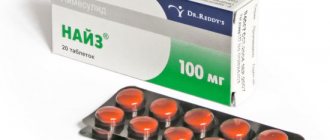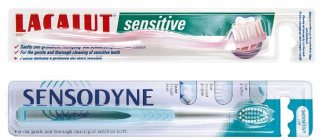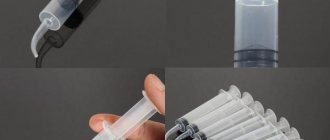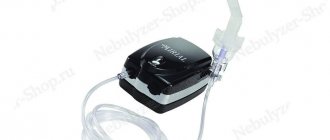Finlepsin® (Finlepsin®)
Monotherapy for epilepsy begins with a low initial dose, gradually increasing it until the desired therapeutic effect is achieved.
When selecting the optimal dose, it is advisable to determine the concentration of carbamazepine in the blood plasma, especially during combination therapy. In some cases, the optimal dose may deviate significantly from the recommended initial and maintenance dose, for example, due to the induction of microsomal liver enzymes or due to interactions during combination therapy.
Finlepsin® should not be combined with sedative-hypnotics. If necessary, it can be combined with other substances used to treat alcohol withdrawal. During treatment, it is necessary to regularly monitor the content of carbamazepine in the blood plasma. Due to the development of side effects from the central and autonomic nervous system, patients are closely monitored in a hospital setting. When transferring a patient to carbamazepine, the dose of the previously prescribed antiepileptic drug should be gradually reduced until it is completely discontinued. Sudden cessation of carbamazepine may trigger epileptic seizures. If it is necessary to abruptly interrupt treatment, the patient should be transferred to another antiepileptic drug under the cover of the drug indicated in such cases (for example, diazepam administered intravenously or rectally, or phenytoin administered intravenously).
Several cases of vomiting, diarrhea and/or decreased nutrition, convulsions and/or respiratory depression have been described in newborns whose mothers took carbamazepine concomitantly with other anticonvulsants (these reactions may represent neonatal withdrawal syndrome). Before prescribing carbamazepine and during treatment, liver function testing is necessary, especially in patients with a history of liver disease, as well as in elderly patients. If existing liver dysfunction worsens or active liver disease develops, the drug should be discontinued immediately. Before starting treatment, it is necessary to conduct a study of the blood picture (including counting platelets, reticulocytes), iron level in the blood serum, general urine analysis, urea level in the blood, electroencephalogram, determination of the concentration of electrolytes in the blood serum (and periodically during treatment, because hyponatremia may develop). Subsequently, these indicators should be monitored weekly during the first month of treatment and then monthly.
In most cases, a transient or persistent decrease in the number of platelets and/or leukocytes is not a precursor to the onset of aplastic anemia or agranulocytosis. However, before starting treatment, and periodically during treatment, clinical blood tests should be performed, including platelet counts and possibly reticulocyte counts, and serum iron levels should be determined. Non-progressive asymptomatic leukopenia does not require discontinuation, however, treatment should be discontinued if progressive leukopenia or leukopenia accompanied by clinical symptoms of an infectious disease occurs. Carbamazepine should be discontinued immediately if hypersensitivity reactions or symptoms suggestive of Stevens-Johnson syndrome or Lyell's syndrome occur. Mild skin reactions (isolated macular or maculopapular exanthema) usually disappear within a few days or weeks, even with continued treatment or after reducing the dose of the drug (the patient should be under close medical supervision at this time).
The possibility of activation of latent psychoses should be taken into account, and in elderly patients, the possibility of developing disorientation or psychomotor agitation.
In some cases, treatment with antiepileptic drugs was accompanied by the occurrence of suicide attempts/suicidal intentions. This was also confirmed in a meta-analysis of randomized clinical trials using antiepileptic drugs. Since the mechanism of suicide attempts when using antiepileptic drugs is not known, their occurrence cannot be ruled out when treating patients with Finlepsin®. Patients and staff should be warned to monitor for suicidal thoughts/behavior and to seek immediate medical attention if symptoms occur.
Male fertility and/or spermatogenesis disorders are possible, but the relationship between these disorders and carbamazepine has not yet been established.
Intermenstrual bleeding may occur with simultaneous use of oral contraceptives. Carbamazepine may adversely affect the reliability of oral contraceptives, so women of reproductive age should use alternative methods of birth control during treatment.
Carbamazepine should only be used under medical supervision. Patients should be informed of early signs of toxicity, as well as skin and liver symptoms. The patient is informed of the need to immediately consult a doctor in case of adverse reactions such as fever, sore throat, rash, ulceration of the oral mucosa, causeless bruising, hemorrhages in the form of petechiae or purpura.
Before starting treatment, it is recommended to conduct an ophthalmological examination, including fundus examination and measurement of intraocular pressure. If the drug is prescribed to patients with increased intraocular pressure, constant monitoring of this indicator is required.
Patients with severe cardiovascular diseases, liver and kidney damage, as well as elderly people are prescribed lower doses of the drug. Although the relationship between the dose of carbamazepine, its concentration and clinical efficacy or tolerability is very small, regular determination of carbamazepine levels may be useful in the following situations: with a sharp increase in the frequency of attacks; to check whether the patient is taking the drug properly; during pregnancy; when treating children or adolescents; if there is a suspicion of impaired absorption of the drug; if toxic reactions are suspected if the patient is taking several medications.
During treatment with Finlepsin® it is recommended to refrain from drinking alcohol.
Pharmacodynamics
An antiepileptic drug (dibenzazepine derivative), which also has antidepressant, antipsychotic and antidiuretic effects, has an analgesic effect in patients with neuralgia.
The mechanism of action is associated with the blockade of voltage-gated sodium channels, which leads to stabilization of the membrane of overexcited neurons, inhibition of the occurrence of serial neuronal discharges and a decrease in synaptic conduction of impulses. Prevents the repeated formation of Na+-dependent action potentials in depolarized neurons. Reduces the release of the excitatory neurotransmitter amino acid glutamate, increases the reduced convulsive threshold of the central nervous system and, thus, reduces the risk of developing an epileptic attack. Increases K+ conductivity, modulates voltage-gated Ca2+ channels, which may also contribute to the anticonvulsant effect of the drug.
Effective for focal (partial) epileptic seizures (simple and complex), accompanied or not accompanied by secondary generalization, for generalized tonic-clonic epileptic seizures, as well as for a combination of these types of seizures (usually ineffective for petit mal seizures, absence seizures and myoclonic seizures ). In patients with epilepsy (especially children and adolescents), a positive effect on symptoms of anxiety and depression, as well as a decrease in irritability and aggressiveness, was noted. The effect on cognitive function and psychomotor performance is dose dependent. The onset of the anticonvulsant effect varies from several hours to several days (sometimes up to 1 month due to autoinduction of metabolism).
In case of essential and secondary trigeminal neuralgia, carbamazepine in most cases prevents the occurrence of painful attacks. Pain relief from trigeminal neuralgia is observed after 8–72 hours.
In alcohol withdrawal syndrome, it increases the threshold of convulsive readiness, which in this condition is usually reduced, and reduces the severity of the clinical manifestations of the syndrome (increased excitability, tremor, gait disturbance).
The antipsychotic (antimanic) effect develops after 7–10 days and may be due to inhibition of the metabolism of dopamine and norepinephrine.
The prolonged dosage form ensures the maintenance of a more stable concentration of carbamazepine in the blood when taken 1-2 times a day.
Side effects
When assessing the frequency of occurrence of various adverse reactions, the following gradations were used: very often (10% or more); often (1–10%); sometimes (0.1–1%); rarely (0.01–0.1%); very rare (less than 0.01%).
The development of adverse reactions from the central nervous system may be a consequence of a relative overdose of the drug or significant fluctuations in the concentration of carbamazepine in the blood plasma.
From the side of the central nervous system: often - dizziness, ataxia, drowsiness, general weakness, headache, accommodation paresis; sometimes - abnormal involuntary movements (for example, tremor, “fluttering” tremor - asterixis, dystonia, tics); nystagmus; rarely - hallucinations (visual or auditory), depression, loss of appetite, anxiety, aggressive behavior, psychomotor agitation, disorientation, activation of psychosis, orofacial dyskinesia, oculomotor disorders, speech disorders (for example, dysarthria or slurred speech), choreoathetoid disorders, peripheral neuritis, paresthesia , muscle weakness and symptoms of paresis. The role of the drug in the development of neuroleptic malignant syndrome, especially in combination with antipsychotics, remains unclear.
Allergic reactions: often - urticaria; sometimes - erythroderma, multiorgan delayed-type hypersensitivity reactions with fever, skin rashes, vasculitis (including erythema nodosum as a manifestation of cutaneous vasculitis), lymphadenopathy, signs resembling lymphoma, arthralgia, leukopenia, eosinophilia, hepatosplenomegaly and altered liver function tests (these manifestations occur in various combinations), other organs may also be involved (for example, lungs, kidneys, pancreas, myocardium, colon), aseptic meningitis with myoclonus and peripheral eosinophilia, anaphylactoid reaction, angioedema, allergic pneumonitis or eosinophilic pneumonia. If the above reactions occur, use of the drug should be discontinued; rarely - lupus-like syndrome, skin itching, exudative erythema multiforme (including Stevens-Johnson syndrome), toxic epidermal necrolysis (Lyell's syndrome), photosensitivity.
From the hematopoietic organs: often - leukopenia, thrombocytopenia, eosinophilia; rarely - leukocytosis, lymphadenopathy, folic acid deficiency, agranulocytosis, aplastic anemia, true erythrocyte aplasia, megaloblastic anemia, acute intermittent porphyria, reticulocytosis, hemolytic anemia, splenomegaly.
From the digestive system: often - nausea, vomiting, dry mouth, increased GGT activity (due to the induction of this enzyme in the liver), which usually has no clinical significance, increased alkaline phosphatase activity; sometimes - increased activity of liver transaminases, diarrhea or constipation, abdominal pain; rarely - glossitis, gingivitis, stomatitis, pancreatitis, cholestatic, parenchymal (hepatocellular) type hepatitis, jaundice, granulomatous hepatitis, liver failure.
From the cardiovascular system: rarely - intracardiac conduction disorders; decrease or increase in blood pressure, bradycardia, arrhythmias, AV block with fainting, collapse, worsening or development of chronic heart failure, exacerbation of coronary heart disease (including the appearance or increased frequency of angina attacks), thrombophlebitis, thromboembolic syndrome.
From the endocrine system and metabolism: often - edema, fluid retention, weight gain, hyponatremia (decrease in plasma osmolarity due to an effect similar to the action of antidiuretic hormone, which in rare cases leads to dilution hyponatremia, accompanied by lethargy, vomiting, headache, disorientation and neurological disorders); rarely - increased concentration of prolactin (may be accompanied by galactorrhea and gynecomastia), decreased concentration of L-thyroxine and increased concentration of thyroid-stimulating hormone (usually not accompanied by clinical manifestations), disturbances of calcium-phosphorus metabolism in bone tissue (decreased concentration of Ca2+ and 25-OH-cholecalciferol in blood plasma): osteomalacia, hypercholesterolemia (including HDL cholesterol), hypertriglyceridemia and enlarged lymph nodes, hirsutism.
From the genitourinary system: rarely - interstitial nephritis, renal failure, renal dysfunction (for example, albuminuria, hematuria, oliguria, increased urea levels/azotemia), frequent urination, urinary retention, decreased potency.
From the musculoskeletal system: rarely - arthralgia, myalgia or convulsions.
From the senses: rarely - impaired taste, increased intraocular pressure, clouding of the lens, conjunctivitis, hearing impairment, incl. tinnitus, hyperacusis, hypoacusia, changes in the perception of pitch.
Other: skin pigmentation disorders, purpura, acne, sweating, alopecia.
Contraindications
hypersensitivity to carbamazepine and other components of the drug, as well as to tricyclic antidepressants;
disorders of bone marrow hematopoiesis (anemia, leukopenia);
acute intermittent porphyria (including history);
atrioventricular block;
simultaneous administration of lithium drugs and MAO inhibitors.
With caution: decompensated chronic heart failure; dilution hyponatremia (ADH hypersecretion syndrome, hypopituitarism, hypothyroidism, adrenal insufficiency); insufficiency of liver and kidney function; elderly patients; active alcoholism (increased depression of the central nervous system, increased metabolism of carbamazepine); suppression of bone marrow hematopoiesis due to medication (history); prostatic hyperplasia; increased intraocular pressure; combination with sedative-hypnotics.
Grandaxin and other tranquilizers
Due to its mild and selective effect, the drug has a minimum of side effects, unlike other anxiolytics. It does not cause the negative consequences inherent in most representatives of this group. The main ones are:
- "Behavioral Toxicity." Manifested by increased sleepiness during the day, weakness and malaise. Characterized by decreased reaction speed and inability to concentrate. Coordination of movements is impaired, and confusion may occur.
- Addiction. A common problem when taking tranquilizers. There is a possibility that it will worsen even to substance abuse. But more often, addiction develops with long-term treatment with such drugs, with an unauthorized increase in dose or concurrent use of alcohol.
- Withdrawal syndrome occurs when you suddenly stop using a tranquilizer. In this case, the symptoms of the disease return to the patient in a more pronounced or even complicated form.
Grandaxin does not exhibit such complications. It is low-toxic and resistance to it is not developed upon repeated use. Therefore, it is taken during the daytime.
The drug does not reduce physical and mental activity and does not lead to drowsiness. It does not suppress the efficiency of perception, the speed of reactions, and does not interfere with professional activities.
Interaction
Co-administration of carbamazepine with CYP3A4 inhibitors may lead to an increase in its concentration in the blood plasma and cause adverse reactions. The combined use of CYP3A4 inducers can lead to an acceleration of the metabolism of carbamazepine, a decrease in the concentration of carbamazepine in the blood plasma and a decrease in the therapeutic effect; on the contrary, their withdrawal can reduce the rate of biotransformation of carbamazepine and lead to an increase in its concentration.
The plasma concentration of carbamazepine is increased by verapamil, diltiazem, felodipine, dextropropoxyphene, viloxazine, fluoxetine, fluvoxamine, cimetidine, acetazolamide, danazol, desipramine, nicotinamide (in adults, only in high doses); macrolides (erythromycin, josamycin, clarithromycin, troleandomycin); azoles (itraconazole, ketoconazole, fluconazole), terfenadine, loratadine, isoniazid, propoxyphene, grapefruit juice, viral protease inhibitors used in the treatment of HIV infection (for example, ritonavir) - dosage adjustment or monitoring of carbamazepine plasma concentrations is required.
Felbamate reduces the plasma concentration of carbamazepine and increases the concentration of carbamazepine-10,11-epoxide, and a simultaneous decrease in the serum concentration of felbamate is possible.
The concentration of carbamazepine is reduced by phenobarbital, phenytoin, primidone, methsuximide, fensuximide, theophylline, rifampicin, cisplatin, doxorubicin, possibly clonazepam, valpromide, valproic acid, oxcarbazepine and herbal preparations containing St. John's wort (Hypericum perforatum). There is a possibility of valproic acid and primidone displacing carbamazepine from binding to plasma proteins and increasing the concentration of the pharmacologically active metabolite (carbamazepine-10,11-epoxide). When finlepsin is used in combination with valproic acid, in exceptional cases, coma and confusion may occur. Isotretinoin alters the bioavailability and/or clearance of carbamazepine and carbamazepine-10,11-epoxide (monitoring of carbamazepine plasma concentrations is necessary).
Carbamazepine may reduce plasma concentrations (reduce or even completely eliminate the effects) and require dose adjustment of the following drugs: clobazam, clonazepam, digoxin, ethosuximide, primidone, valproic acid, alprazolam, corticosteroids (prednisolone, dexamethasone), cyclosporine, tetracyclines (doxycycline), haloperidol, methadone, oral medications containing estrogens and/or progesterone (selection of alternative methods of contraception is necessary), theophylline, oral anticoagulants (warfarin, phenprocoumon, dicumarol), lamotrigine, topiramate, tricyclic antidepressants (imipramine, amitriptyline, nortriptyline, clomipramine), clozapine , фелбамата, тиагабина, окскарбазепина, ингибиторов протеаз, применяемых при терапии ВИЧ-инфекции (индинавира, ритонавира, саквинавира), БКК (группа дигидропиридина, например фелодипин), итраконазола, левотироксина, мидазолама, оланзапина, празиквантела, рисперидона, трамадола, зипрасидона.
There is a possibility of an increase or decrease in phenytoin plasma levels in the presence of carbamazepine and an increase in mephenytoin levels. With the simultaneous use of carbamazepine and lithium preparations, the neurotoxic effects of both active substances may be enhanced.
Tetracyclines may weaken the therapeutic effect of carbamazepine. When used together with paracetamol, the risk of its toxic effect on the liver increases and therapeutic effectiveness decreases (acceleration of paracetamol metabolism).
The simultaneous administration of carbamazepine with phenothiazine, pimozide, thioxanthenes, molindone, haloperidol, maprotiline, clozapine and tricyclic antidepressants leads to an increased inhibitory effect on the central nervous system and a weakening of the anticonvulsant effect of carbamazepine.
MAO inhibitors increase the risk of developing hyperpyretic crises, hypertensive crises, convulsions, and death (before prescribing carbamazepine, MAO inhibitors should be discontinued at least 2 weeks in advance or, if the clinical situation allows, even longer).
Concomitant administration with diuretics (hydrochlorothiazide, furosemide) can lead to hyponatremia, accompanied by clinical manifestations.
Weakens the effects of non-depolarizing muscle relaxants (pancuronium). If this combination is used, it may be necessary to increase the dose of muscle relaxants, and careful monitoring of the patient's condition is necessary due to the possibility of faster cessation of the effect of muscle relaxants.
Carbamazepine reduces ethanol tolerance.
Myelotoxic drugs increase the manifestations of hematotoxicity of the drug.
Accelerates the metabolism of indirect anticoagulants, hormonal contraceptives, folic acid, praziquantel, and may enhance the elimination of thyroid hormones.
Accelerates the metabolism of anesthetics (enflurane, halothane, fluorothane) and increases the risk of developing hepatotoxic effects; enhances the formation of nephrotoxic metabolites of methoxyflurane. Strengthens the hepatotoxic effect of isoniazid.
Use during pregnancy and breastfeeding
For women of reproductive age, Finlepsin® retard is, if possible, prescribed as monotherapy, in the minimum effective dose, because the incidence of congenital anomalies in newborns from mothers taking combined antiepileptic treatment is higher than with monotherapy.
When pregnancy occurs, it is necessary to compare the expected benefits of therapy and possible complications, especially in the first trimester of pregnancy. It is known that children of mothers with epilepsy are predisposed to disorders of intrauterine development, including malformations. Finlepsin® retard may increase the risk of these disorders. There are isolated reports of cases of congenital diseases and malformations, including spina bifida.
Antiepileptic drugs increase folic acid deficiency, which is often observed during pregnancy, which may increase the incidence of birth defects in children, so folic acid supplementation is recommended before and during pregnancy. In order to prevent hemorrhagic complications in newborns, it is recommended that women in the last weeks of pregnancy, as well as newborns, be prescribed vitamin K.
Carbamazepine passes into breast milk, so the benefits and possible undesirable effects of breastfeeding should be weighed against ongoing therapy. If breastfeeding continues while taking the drug, the child should be monitored due to the possibility of adverse reactions (for example, severe drowsiness, allergic skin reactions).







